Never miss another geomagnetic storm. Sign up for Space Weather Alerts and you'll receive a text message when magnetic storms erupt. Aurora tour guides and professional astronomers use this service. You can, too! | | |
BRIGHTENING COMET: Comet ZTF (C/2022 E3) continues to brighten as it approaches Earth for a close encounter (0.28 AU) on Feb. 1st. Experienced observers are now reporting brightness values as high as magnitude +4.6. This means it is visible to the naked eye from very dark sites and a great target for small telescopes. Point your optics here.
BIG FARSIDE SUNSPOT: A big farside sunspot may be hiding just behind the sun's southeastern limb. Its location is marked by the big dark "echo" in this helioseismic map of the sun from NASA's Solar Dynamic Observatory:
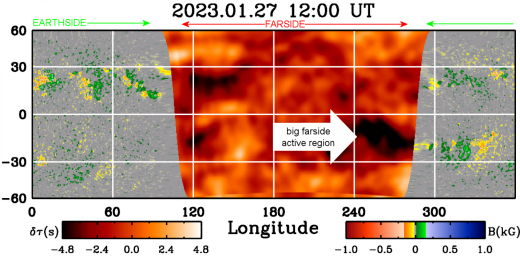
This could be old sunspot AR3182, returning after a two-week trip around the farside of the sun. In early January, AR3182 produced an X1-class solar flare (movie) and multiple strong M-class flares. If it has indeed survived its farside transit, the potent sunspot could boost the chance of strong flares when it turns to face Earth again in February. Solar flare alerts: SMS Text.
Realtime Space Weather Photo Gallery
Free: Spaceweather.com Newsletter
FIRE AND ICE--COMET ZTF OVER MOUNT ETNA: Astrophotographer Dario Giannobile has been yearning to photograph Comet ZTF (C/2022 E3). "Animated by this desire, I took advantage of the only night with clear skies that occurred in this last ten days of January," says Giannobile. "My destination? Snowy Mt. Etna!"
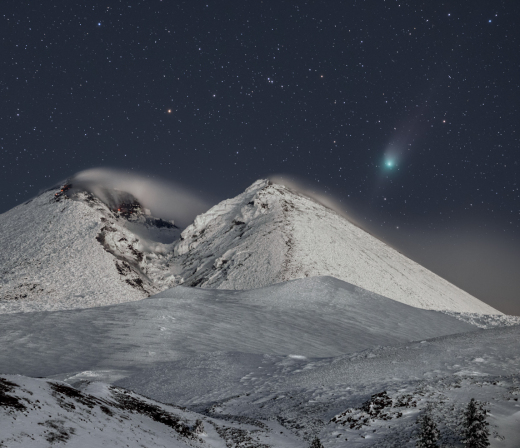
Mt. Etna in eastern Sicily is one of the most active volcanoes in the world. Right now its hot vents are surrounded by deep snow--a marvelous yet challenging backdrop for comet photography.
"During the night the temperature dropped to -8°C at an altitude of 2000 meters, an exceptionally cold temperature for Sicily!" says Giannobile. "However, the landscape was breathtaking: an expanse of soft snow disturbed only by some fox and rabbit footprints. In the South East crater, some hot spots appear in the dark. They are fumaroles from which volcanic vapors come out... and in all this, the beauty of the sky with the splendid comet rising from the side of the volcano."
"The view was breathtaking, expressing, in a single image, a feeling of strength and delicacy, fire and ice."
Realtime Comet ZTF Photo Gallery
Free: Spaceweather.com Newsletter
PREMIUM VALENTINE'S PENDANT: Are you looking for an unforgettable Valentine's Day gift? Consider the Always and Forever Space Pendent. The students of Earth to Sky Calculus launched it to the stratosphere onboard a cosmic ray research balloon:
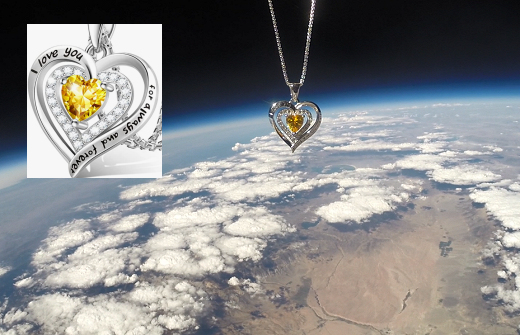
You can have it for $199.95. Engraved with the words "I love you always and forever", this 18K gold-plated pendant has a heart-shaped citrine crystal in the middle surrouunded by a ring of glittering 5A cubic zirconia nuggets. It is a visually striking premium pendant that makes a once-in-a-lifetime Valentine's, anniversary or birthday gift.
The students are selling space pendants to pay the helium bill for their cosmic ray ballooning program. Each one comes with a greeting card showing the jewelry in flight and telling the story of its trip to the stratosphere and back again.
Far Out Gifts: Earth to Sky Store
All sales support hands-on STEM education
Realtime Aurora Photo Gallery
Free: Spaceweather.com Newsletter
Every night, a network of
NASA all-sky cameras scans the skies above the United States for meteoritic fireballs. Automated software maintained by NASA's Meteoroid Environment Office calculates their orbits, velocity, penetration depth in Earth's atmosphere and many other characteristics. Daily results are presented here on Spaceweather.com.
On Jan 28 2023, the network reported 13 fireballs.
(13 sporadics)
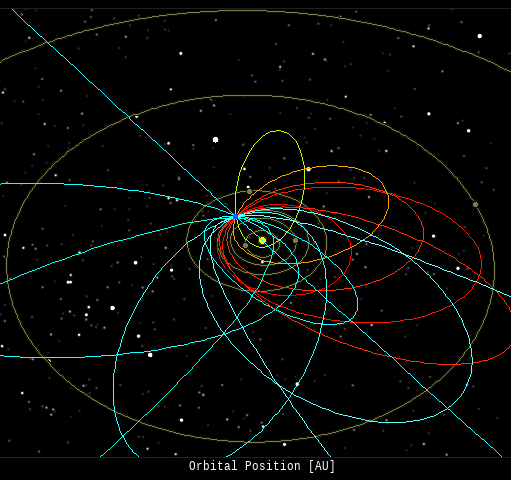
In this diagram of the inner solar system, all of the fireball orbits intersect at a single point--Earth. The orbits are color-coded by velocity, from slow (red) to fast (blue). [Larger image] [movies]
Potentially Hazardous Asteroids (
PHAs) are space rocks larger than approximately 100m that can come closer to Earth than 0.05 AU. None of the known PHAs is on a collision course with our planet, although astronomers are finding
new ones all the time.
On January 28, 2023 there were 2326 potentially hazardous asteroids.
 |
Recent & Upcoming Earth-asteroid encounters: | Asteroid | Date(UT) | Miss Distance | Velocity (km/s) | Diameter (m) |
| 2023 BA1 | 2023-Jan-23 | 1.1 LD | 12.6 | 15 |
| 2023 BN4 | 2023-Jan-23 | 7.2 LD | 12 | 60 |
| 2023 BK1 | 2023-Jan-23 | 16.9 LD | 10.9 | 31 |
| 2019 BO2 | 2023-Jan-24 | 12.1 LD | 16.2 | 21 |
| 2019 BZ4 | 2023-Jan-24 | 16.5 LD | 5.6 | 20 |
| 2023 BQ5 | 2023-Jan-24 | 4.3 LD | 7.7 | 14 |
| 2023 BH1 | 2023-Jan-24 | 3.6 LD | 10 | 13 |
| 2023 BE2 | 2023-Jan-25 | 1.9 LD | 9.7 | 8 |
| 2023 AQ1 | 2023-Jan-25 | 10.2 LD | 15.7 | 55 |
| 2023 AP1 | 2023-Jan-25 | 10.2 LD | 9.4 | 27 |
| 2023 BY | 2023-Jan-25 | 8.5 LD | 11.6 | 18 |
| 2023 BL1 | 2023-Jan-25 | 0.6 LD | 14.7 | 20 |
| 2023 AM1 | 2023-Jan-25 | 11.5 LD | 5.8 | 18 |
| 2023 BL2 | 2023-Jan-26 | 1 LD | 10.5 | 6 |
| 2020 BZ14 | 2023-Jan-26 | 8.8 LD | 6.7 | 54 |
| 2023 BH5 | 2023-Jan-26 | 7.2 LD | 7.6 | 13 |
| 2023 BU | 2023-Jan-27 | 0 LD | 9.3 | 5 |
| 2023 BZ3 | 2023-Jan-27 | 0.7 LD | 6.8 | 5 |
| 2023 BT3 | 2023-Jan-27 | 1.5 LD | 9.6 | 4 |
| 2023 BN5 | 2023-Jan-27 | 3.4 LD | 6.5 | 13 |
| 2023 BC | 2023-Jan-28 | 7.4 LD | 12.8 | 37 |
| 2023 BL4 | 2023-Jan-29 | 11.1 LD | 7.8 | 21 |
| 2023 BM5 | 2023-Jan-29 | 2 LD | 15.5 | 13 |
| 2022 SO113 | 2023-Jan-29 | 10.5 LD | 3.5 | 73 |
| 2023 BK4 | 2023-Jan-29 | 7.3 LD | 8.2 | 21 |
| 2023 BA3 | 2023-Jan-30 | 3.4 LD | 8.8 | 19 |
| 2023 AS1 | 2023-Jan-31 | 11.8 LD | 6.2 | 26 |
| 2023 BA4 | 2023-Jan-31 | 17.6 LD | 7.9 | 48 |
| 2023 BQ2 | 2023-Jan-31 | 5.7 LD | 13.9 | 17 |
| 2017 DU34 | 2023-Feb-02 | 13.3 LD | 11.2 | 16 |
| 2023 BY4 | 2023-Feb-02 | 12.8 LD | 10.7 | 39 |
| 2023 BP5 | 2023-Feb-02 | 4.4 LD | 6.2 | 13 |
| 2023 BR5 | 2023-Feb-03 | 10.9 LD | 7.9 | 12 |
| 367789 | 2023-Feb-03 | 4.7 LD | 9.9 | 149 |
| 2020 OO1 | 2023-Feb-04 | 4.8 LD | 7.7 | 19 |
| 2023 BC4 | 2023-Feb-04 | 16.2 LD | 11.6 | 52 |
| 2023 BG4 | 2023-Feb-05 | 17.2 LD | 10.4 | 34 |
| 2023 BT1 | 2023-Feb-06 | 16.8 LD | 8.7 | 29 |
| 2022 YO6 | 2023-Feb-06 | 12.1 LD | 13.4 | 166 |
| 2023 BS | 2023-Feb-08 | 19.4 LD | 10.9 | 35 |
| 2022 CX1 | 2023-Feb-09 | 17.4 LD | 13.2 | 14 |
| 2021 EP4 | 2023-Feb-13 | 19 LD | 6.1 | 5 |
| 199145 | 2023-Feb-16 | 12 LD | 24.6 | 756 |
| 2022 RG | 2023-Feb-16 | 8.2 LD | 3 | 24 |
| 2020 DG4 | 2023-Feb-17 | 1.4 LD | 6.9 | 8 |
| 2020 CX1 | 2023-Feb-19 | 17.4 LD | 7.7 | 53 |
| 37638 | 2023-Feb-21 | 17 LD | 11.1 | 495 |
| 2023 AA2 | 2023-Feb-22 | 17.4 LD | 10.1 | 132 |
| 2012 DK31 | 2023-Feb-27 | 12.6 LD | 15.5 | 148 |
| 2006 BE55 | 2023-Feb-28 | 9.4 LD | 13.3 | 148 |
| 2021 QW | 2023-Mar-03 | 13.9 LD | 12.1 | 79 |
| 2017 BM123 | 2023-Mar-03 | 12.1 LD | 7.8 | 62 |
| 2007 ED125 | 2023-Mar-03 | 11.7 LD | 13.1 | 224 |
| 2015 EG | 2023-Mar-04 | 13.9 LD | 10.6 | 27 |
| 2023 BK5 | 2023-Mar-05 | 17.9 LD | 8.5 | 59 |
| 535844 | 2023-Mar-07 | 10.5 LD | 7.7 | 150 |
| 2020 FQ | 2023-Mar-09 | 14 LD | 6.3 | 13 |
| 2020 FV4 | 2023-Mar-13 | 17.6 LD | 8.2 | 30 |
| 2018 UQ1 | 2023-Mar-17 | 10.7 LD | 11.7 | 143 |
| 2016 WH | 2023-Mar-19 | 18.1 LD | 11.8 | 14 |
| 2018 FE3 | 2023-Mar-21 | 10.1 LD | 5.4 | 13 |
Notes: LD means "Lunar Distance." 1 LD = 384,401 km, the distance between Earth and the Moon. 1 LD also equals 0.00256 AU. | | Cosmic Rays in the Atmosphere |
SPACE WEATHER BALLOON DATA: Almost once a week, Spaceweather.com and the students of Earth to Sky Calculus fly space weather balloons to the stratosphere over California. These balloons are equipped with sensors that detect secondary cosmic rays, a form of radiation from space that can penetrate all the way down to Earth's surface. Our monitoring program has been underway without interruption for 7 years, resulting in a unique dataset of in situ atmospheric measurements.
Latest results (July 2022): Atmospheric radiation is decreasing in 2022. Our latest measurements in July 2022 registered a 6-year low:
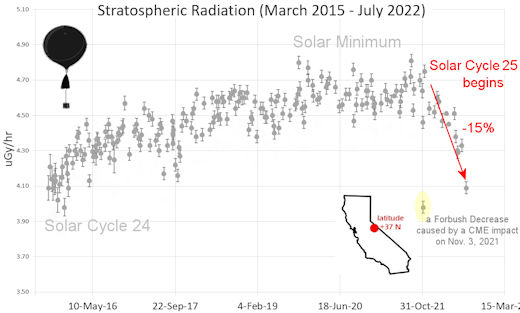
What's going on? Ironically, the radiation drop is caused by increasing solar activity. Solar Cycle 25 has roared to life faster than forecasters expected. The sun's strengthening and increasingly tangled magnetic field repels cosmic rays from deep space. In addition, solar coronal mass ejections (CMEs) sweep aside cosmic rays, causing sharp reductions called "Forbush Decreases." The two effects blend together to bring daily radiation levels down.
.Who cares? Cosmic rays are a surprisingly "down to Earth" form of space weather. They can alter the chemistry of the atmosphere, trigger lightning, and penetrate commercial airplanes. According to a study from the Harvard T.H. Chan school of public health, crews of aircraft have higher rates of cancer than the general population. The researchers listed cosmic rays, irregular sleep habits, and chemical contaminants as leading risk factors. A number of controversial studies (#1, #2, #3, #4) go even further, linking cosmic rays with cardiac arrhythmias and sudden cardiac death.
Technical notes: The radiation sensors onboard our helium balloons detect X-rays and gamma-rays in the energy range 10 keV to 20 MeV. These energies span the range of medical X-ray machines and airport security scanners.
Data points in the graph labeled "Stratospheric Radiation" correspond to the peak of the Regener-Pfotzer maximum, which lies about 67,000 feet above central California. When cosmic rays crash into Earth's atmosphere, they produce a spray of secondary particles that is most intense at the entrance to the stratosphere. Physicists Eric Regener and Georg Pfotzer discovered the maximum using balloons in the 1930s and it is what we are measuring today.
| | The official U.S. government space weather bureau |
| | The first place to look for information about sundogs, pillars, rainbows and related phenomena. |
| | Researchers call it a "Hubble for the sun." SDO is the most advanced solar observatory ever. |
| | 3D views of the sun from NASA's Solar and Terrestrial Relations Observatory |
| | Realtime and archival images of the Sun from SOHO. |
| | information about sunspots based on the latest NOAA/USAF Active Region Summary |
| | current counts of failed and deployed Starlink satellites from Jonathan's Space Page |
| | Authoritative predictions of space junk and satellite re-entries |
| | from the NOAA Space Environment Center |
| | fun to read, but should be taken with a grain of salt! Forecasts looking ahead more than a few days are often wrong. |
| | from the NOAA Space Environment Center |
| | the underlying science of space weather |
 | BestCSGOGambling is the best site for everything related to CSGO gambling on the web |
 | To find reviews of new online casino sites in the UK try The Casino DB where there are hundreds of online casino reviews complete with bonuses and ratings. Alternatively, Online-Casinos.xyz is another massive directory of online casinos listing sites for the UK and Worldwide. Casinos that offer Rupees for bonuses are very generous to Indian players. Find the best online casinos in India at AllCasinos.in Looking for a new online casino? Try Casimpo the new site dedicated to making online casino simple, or check out the new Avenger Slots Casino and Ace Online Casino with over 500 online slots and casino games. |
 | When looking for casinos to play online when the weather is bad, you can try casino online trucchi for Italian games. If you are not from Finland you can try the Swedish page Svenska casino online to find suitable games, check out svenskacasinoonline.net. Always check your local laws before playing with real money. |
 | Looking for sports betting companies not registered on GamStop? CasinoGap has presented a list of sites not on GamStop available for UK players. Check and bet online! Would you like to bet at sites not using GamStop? Look at a list of NonStopCasino sites for online betting that aren't on GamStop. Top-rated bookmakers ever! |
| | These links help Spaceweather.com stay online. Thank you to our supporters! |
| | | | | | |

